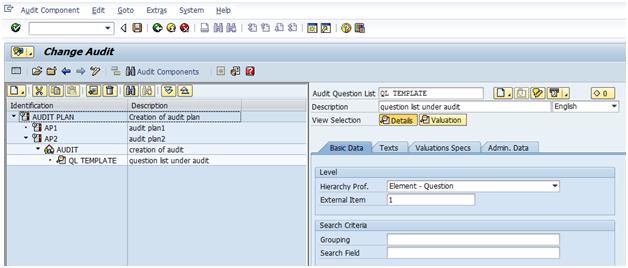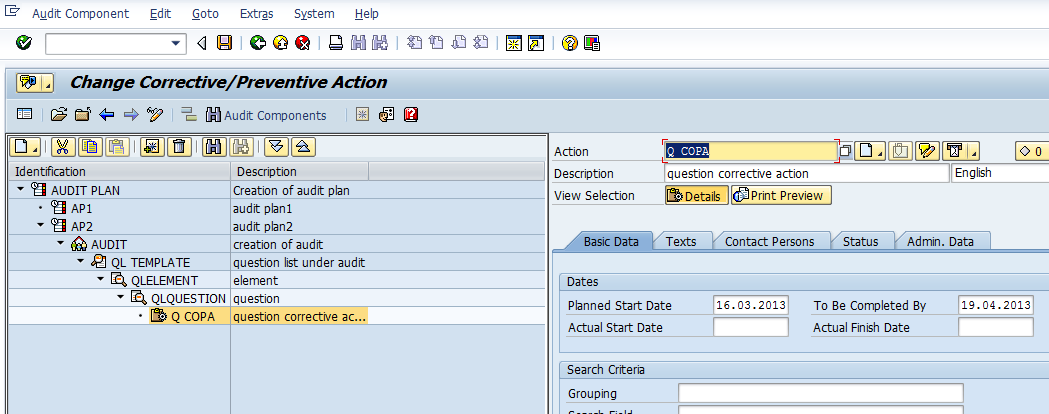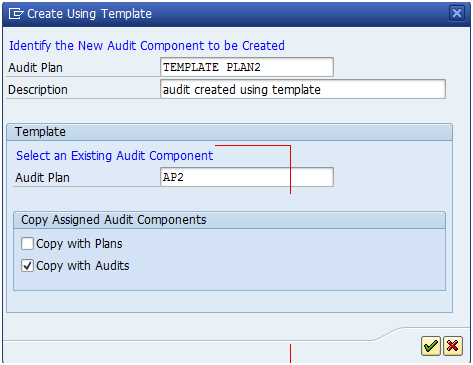
- SAP Community
- Groups
- Interest Groups
- Application Development
- Blog Posts
- Audit Management: Step by step to create an audit
- Subscribe to RSS Feed
- Mark as New
- Mark as Read
- Bookmark
- Subscribe
- Printer Friendly Page
- Report Inappropriate Content
- Audit Management
SAP Audit Management is a tool that supports performing any kind of audit. Audit management facilitates
systematic examination to determine whether or not an object meets predefined requirements. It provides
ability to define question lists and evaluate the results and document.
2. Components in Audit Management
The different components of audit are
- Audit Plan
- Audit
- Question list
- Part
- Element
- Question
- Corrective and Preventive action
2.1 Audit Plan
The audit plan consists of an audit that needs to performed over a period of time.
It also consist of audit plans
In the navigation area, audit plans are indicated by the icon 
- You can assign as many audits as required to an audit plan.
- You can assign as many additional audit plans as required to an audit plan.
2.2 Audit
An audit is a systematic, independent, and documented process used to obtain
audit results and to evaluate these results objectively in order to determine to what
extent the criteria of the audit have been fulfilled.
In the navigation area, audits are indicated by the icon  .
.
- An audit can be assigned to audit plan or it can be independent.
- You can assign as many audit question lists as required to an audit.
- Corrective/preventive actions are assigned to the audit questions which are in turn assigned to an audit
2.3 Question List
Question lists contain the questions that need to be answered during the execution of the audit.
The allowed valuation can be planned for each hierarchy level.
There are two different types of question list in audit management:
Question List (Master Record): This question list simply serves as a copying template for
audit question lists. It does not contain any reply fields.
Audit Question List: This question list is used for the audit execution. It is a (modified) copy
of the master record question list and contains reply fields.
An audit question list can be created by assigning a question list(Master Record) to an audit or
by creating a new question list directly under the audit.
In the navigation area, question lists are indicated by the icon  , and subordinate
, and subordinate
hierarchy levels (questions, part, element etc…) are indicated by the icon  .
.
In the navigation area, Audit question lists are indicated by the icon  , and subordinate
, and subordinate
hierarchy levels (questions, part, element etc…) are indicated by the icon  .
.
A question list can contain as many hierarchy levels as required (for example:part, element, question).
Each of these hierarchy levels can except the last level, in turn, contain additional hierarchy levels. The
allowed valuation can be planned for each hierarchy level.
- Question lists (master record) are used as templates for audit question lists.
- An audit can link to as many audit question lists as required.
- Question lists do not have to be assigned to an audit.
- A corrective/preventive action can refer to an audit question list or to a single node of an audit question list.
2.4 Corrective and Preventive action
Corrective Actions
These are actions that are deemed necessary to eliminate the cause of errors that were determined during
the audit and to prevent the recursion of these errors. The corrective actions to be executed must be appropriate
to the effects that the particular error has on the product.
Preventive Actions
These are actions that are deemed necessary to eliminate the causes of possible errors before they occur.
The preventive actions to be executed must be appropriate to the effects that the possible error could have
on the product.
In the navigation area, corrective/preventive actions are indicated by the icon  .
.
Corrective and preventive actions can be assigned to any hierarchy level of an audit-related question list.
3. Creation of Audit components individually
Go to the transaction PLMD_AUDIT
The audits can be created by two ways.
- Creating directly
- Creating using template
When we create audits directly we have to create them from scratch. I.e. we need to create each audit components newly.
When the audit is created from the template the entire audit components of the referenced template gets created under the
newly created audit and then it can be modified according to our needs.
A template is nothing but an already existing audit.
Now let us see the step by step process of creating an audit.
3.1 Creation of Audit Plan
Press the create button and select audit plan from the listed options.

Provide the audit plan name and its description.
Provide the necessary details for the audit plan in each tab and save the audit.

We can create multiple audit plan or audit under the audit plan.


3.2 Creation of Question List
Select question list under the create option

Provide name, description, hierarchy level and other details for the question list.

The hierarchy level can be one level (question), two levels (Element- question) or three levels (part- Element- question).
For simplicity I have selected hierarchy profile as one level.
3.2.1 Creation of Question
Create question under the question list.
We can create N- no of questions under the question list

Provide the name, description and other details of the question.

Texts
If you want to provide some text for description and note provide it under the text tab

Valuation Specs
Provide the valuation specs to evaluate the audit

3.3 Creation of Audit
Audit can be created directly or it can be created under the Audit plan
Creating the audit directly

Provide the audit name, description.
Then provide the audit type, audit trigger, audit object values, planned start date,
planned end date and other necessary details in the other tabs.

Audit Type:The audit type describes the audit usage, the audit categories, and the audit object that is to be audited. Examples of audit types are: Internal process audits in the development area, external vendor product audits, and internal QM System audits.
Audit Trigger:The audit trigger describes why an audit is executed
Creating question list under the Audit
Question list can be created under the audit by three ways
- By assigning the existing question list
- By creating question list directly under audit
- By creating question list using template under the audit
Assigning question list to an audit

Select the question list that needs to be assigned to the audit from thelist

The selected question list will be assigned to the audit with the standard naming convention provided by the SAP.

Creating question list directly under audit

Provide the details of the question list

Here the hierarchy profile has been set to two levels (Element-Question)
Create an element under the question list.

Provide the details for the element

Create question for the element

Provide the details for the question

3.4 Creation of corrective and preventive action
Corrective and preventive action has to be created for the each question list, elements, questions of the
audits for which the status has been set as released.
The status of the audit can be set to release under the status tab of the audit.

Create the corrective and preventive action for the question: Questions1

Provide the name, description and other necessary details of the corrective action.

Thus we have created Audit plan, audit, question list and corrective and preventive action individually.
4. Creation of Audit components under Audit plan
We have seen creation of audit components individually.
Now let us create them all under the audit plan.

Provide the details of the audit

Create question list under the audit
Here I am creating question list using template (i.e. from the existing question list)


Select the question list for the template from the hit list


Question list is created with the properties of the given template

Create element

Provide the name and other details of the element.

Create a question under the element.

Provide the details for the question.

Create corrective action for the question

Provide the details of the corrective action

Create corrective action for the element

Provide the details of the corrective action

Creation of audit using template
Now I am creating an audit under the audit plan using the template. When we create an audit using the template,
the question list and the questions of the template audit will be automatically get created under the new audit.


As mentioned above the question list and its sub components are created along with the audit. Now if we need to
add some other question list or questions we can add them under the created audit.

5. Creation of Audit plan using template

Now I am creating the audit plan using template without copying the audit plan and audits under the template audit plan, hence only the audit plan without its subcomponents will be created.

As mentioned audit plan without the sub components got created.

Now we will created the audit plan using template with selecting the copy with audit option.

Audit plan with the audits under it got created.

Now let us create the audit plan using template with the copy with plans option selected.

Audit plan along with its sub audit plans is created.

Finally we will create audit plan using template with both the options selected.

Audit plan with its entire sub audit plans and their respective audits is created.

6. References
http://help.sap.com/saphelp_crm40/helpdata/EN/43/04273aeaa07123e10000000a114084/content.htm
http://help.sap.com/saphelp_crm40/helpdata/EN/87/04273aeaa07123e10000000a114084/content.htm
http://help.sap.com/saphelp_crm40/helpdata/EN/65/04273aeaa07123e10000000a114084/content.htm
http://help.sap.com/saphelp_crm40/helpdata/EN/21/04273aeaa07123e10000000a114084/content.htm
- SAP Managed Tags:
- ABAP Development
You must be a registered user to add a comment. If you've already registered, sign in. Otherwise, register and sign in.
-
A Dynamic Memory Allocation Tool
1 -
ABAP
8 -
abap cds
1 -
ABAP CDS Views
14 -
ABAP class
1 -
ABAP Cloud
1 -
ABAP Development
4 -
ABAP in Eclipse
1 -
ABAP Keyword Documentation
2 -
ABAP OOABAP
2 -
ABAP Programming
1 -
abap technical
1 -
ABAP test cockpit
7 -
ABAP test cokpit
1 -
ADT
1 -
Advanced Event Mesh
1 -
AEM
1 -
AI
1 -
API and Integration
1 -
APIs
8 -
APIs ABAP
1 -
App Dev and Integration
1 -
Application Development
2 -
application job
1 -
archivelinks
1 -
Automation
2 -
BTP
1 -
CAP
1 -
CAPM
1 -
Career Development
3 -
CL_GUI_FRONTEND_SERVICES
1 -
CL_SALV_TABLE
1 -
Cloud Extensibility
8 -
Cloud Native
6 -
Cloud Platform Integration
1 -
CloudEvents
2 -
CMIS
1 -
Connection
1 -
container
1 -
Debugging
2 -
Developer extensibility
1 -
Developing at Scale
4 -
DMS
1 -
dynamic logpoints
1 -
Eclipse ADT ABAP Development Tools
1 -
EDA
1 -
Event Mesh
1 -
Expert
1 -
Field Symbols in ABAP
1 -
Fiori
1 -
Fiori App Extension
1 -
Forms & Templates
1 -
IBM watsonx
1 -
Integration & Connectivity
9 -
JavaScripts used by Adobe Forms
1 -
joule
1 -
NodeJS
1 -
ODATA
3 -
OOABAP
3 -
Outbound queue
1 -
Product Updates
1 -
Programming Models
12 -
RFC
1 -
RFFOEDI1
1 -
SAP BAS
1 -
SAP BTP
1 -
SAP Build
1 -
SAP Build apps
1 -
SAP Build CodeJam
1 -
SAP CodeTalk
1 -
SAP Odata
1 -
SAP UI5
1 -
SAP UI5 Custom Library
1 -
SAPEnhancements
1 -
SapMachine
1 -
security
3 -
text editor
1 -
Tools
14 -
User Experience
4
| User | Count |
|---|---|
| 6 | |
| 2 | |
| 2 | |
| 2 | |
| 2 | |
| 2 | |
| 2 | |
| 1 |